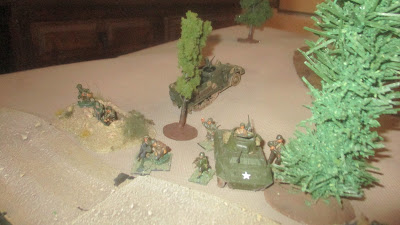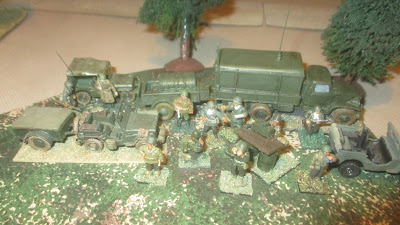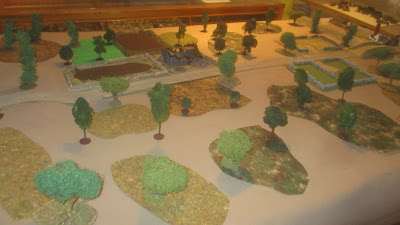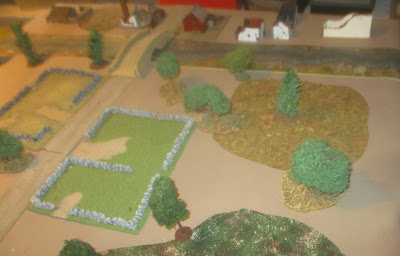Collecchio Game 2
German Breakout Attempt
This is the second game based around the Battle at Collecchio, Italy 26-27 April 1945. I laid our my plan for a couple of games based on this late war action in an earlier post and suggest anyone reading this refers to that piece for a more complete background.
https://baberonwargames.blogspot.com/2023/11/collecchio.html
One
last desperate throw of the dice and break through to Highway 62 and the way
north. The Germans moved units around Collecchio through the thickly wooded
areas, then launched an attack against the dug in Brazilians above the town.
The victory conditions are simple – the Germans must break through and open the
highway for their comrades bottled up south of the town. The Brazilians must
hold the line preventing any German units escaping the valley.
German force
Elements
of 148th Infantry Division
Composite
Battalion HQ:
CO,
2IC, 3 officers, 2 RTO, NCO, 4 runners,
8
man security platoon (LMG)
12
– Weak platoons with:
9
men each (weapons to be divided among platoons – 7 LMG, 1 Panzershreck [1D3
rockets], 3 Panzerfaust, 1 Flamethrower [3 bursts], sniper rifle, 1 grenade
rifle)
2
– MMG (man packed 9 figures inc 4 ammo bearers)
2
– 81mm mortars (1D6 turns of ammo) (man packed 9 men inc ammo bearers)
Support - the game starts with the Germans getting 3 turns of random 105mm fire off two guns onto the Brazilian positions.
Brazilian Forces
All troops can be entrenched
Composite HQ
CO
(Gen. Mascarenhas), 2IC, 3 officers,
2 RTO, FOO, 4 runners, 10 man security platoon (BAR) + transport and medical
detail
Coy
HQ – CO, RTO, NCO, 3 runners
3
– 10 man platoons (1 BAR)
Support
platoon - .30cal, Bazooka, 60mm mortar (10 men)
As
6th Company above
2
x MMGs
M8
armoured car
M3
half-track w/.50cal - 8 man platoon (BAR)
Battery 81mm mortars (8th company, II
Battalion, 11th Infantry) 2 tubes
My table
Initial deployment
The Brazilians deployed along the rough road
leading out of Collecchio to the west, the centre of their line being the
ruined farmhouse. They deployed 6th Coy on the left, 9th
Coy in the centre one MMG was given to each company for direct support; the
recce squadron was on the far right, they deployed a .50cal HMG off their
half-track. The mortar FOO was placed dead centre of the table to give him the
best overall view to call in support fire for either company.

6th
Coy on the left, MMG position

Troops
of 9th Coy in the ruined farm

Recce
Squadron on the far right
The Germans elected to have wide deployment
across the entire width of the table, though they held three platoons in reserve
to follow the lead units on turn 3. The divided the MMGs among two of the lead
platoons so they could be well forward and provide fire support during the
assault phase on the Brazilian positions. They also divided the HQ into two units,
one of which took direct command of the mortars, the other formed a command
unit/platoon within the attacking platoons, so they could if needed rally or
change platoon orders, both command sections had a radio link allowing them to
communicate.

Turns
1-3 As the Germans advanced their 105mm guns dropped shells among the Brazilian
positions

These
caused some casualties among both companies, 9th Coy lost both its
.30cal machine gun and 60mm mortar to this fire!
Brazilian
81mm mortars did cause a few casualties among the advancing Germans in return.

Turns
4-5 The Germans continue their advance, but are now within HMG and MMG range as
well as continued mortaring. The platoon on the far left walks right into the
recce Squadron and is decimated by .50cal and vehicle mounted MMG fire! The fail
a morale check and break at the start of turn 6!!

Turn
6 The Germans deploy their MMGs and 75IG to support a direct assault on the
Brazilians
Their 81mm mortars are now targeting the .30cal MMG position in the middle of 6th Coy`s line.
Turn
7 The .30cal is wiped out and the Germans press forward against 6th
Coy, the German MMGs support this advance and the general attack on the centre
and the ruined farm, which is also targeted by the 75IG

Turn
8 two German platoons are shot to pieces on the far right trying to turn the
flank of 6th Company, but two others cross stone walls into the
fields at the companies centre threatening a breakthrough!

On
the Brazilian right the Recce Squadron finds itself without attackers so begins
a move to strike into the German left flank

The
Germans are throwing everything at 9th Company and the farmhouse,
which is being raked by MMG and again targeted by the 75IG

The
German mortars are now out of ammunition, so the command platoon orders the men
to pick up their rifles and move forward to support their comrades.

Turn
9 The Germans on the right are stopped dead crossing those open fields. In the
centre supported by MMG and IG fire, two platoons make a desperate close
assault across the road to the ruined farm. Their attached flame-thrower causes
casualties and a morale check!

A
combination of MMG, BAR and the Germans attacking over an open road result in
them taking awful casualties! They too require a morale check……….
Turn
10 The Brazilian morale holds (just), the Germans fail their check and run back
to the comparative shelter of the road side ditch, but it is at this point the
Recce Squadron hits them in the flank causing more casualties and yet another
check – which they blow badly and break!!

With
both flanks exposed and the Brazilians still well entrenched, the Germans can
do no more and withdraw.
A closer run thing than it looked in the AAR, a bit more luck with “to hit” rolls and one failed Brazilian morale check and the result could have been quite different.
As I wrote in my initial post (see link above) if you play Rapid Fire! or another battalion level set you could quite easily play both these two games as one on a single table with little or no re-writing.



























